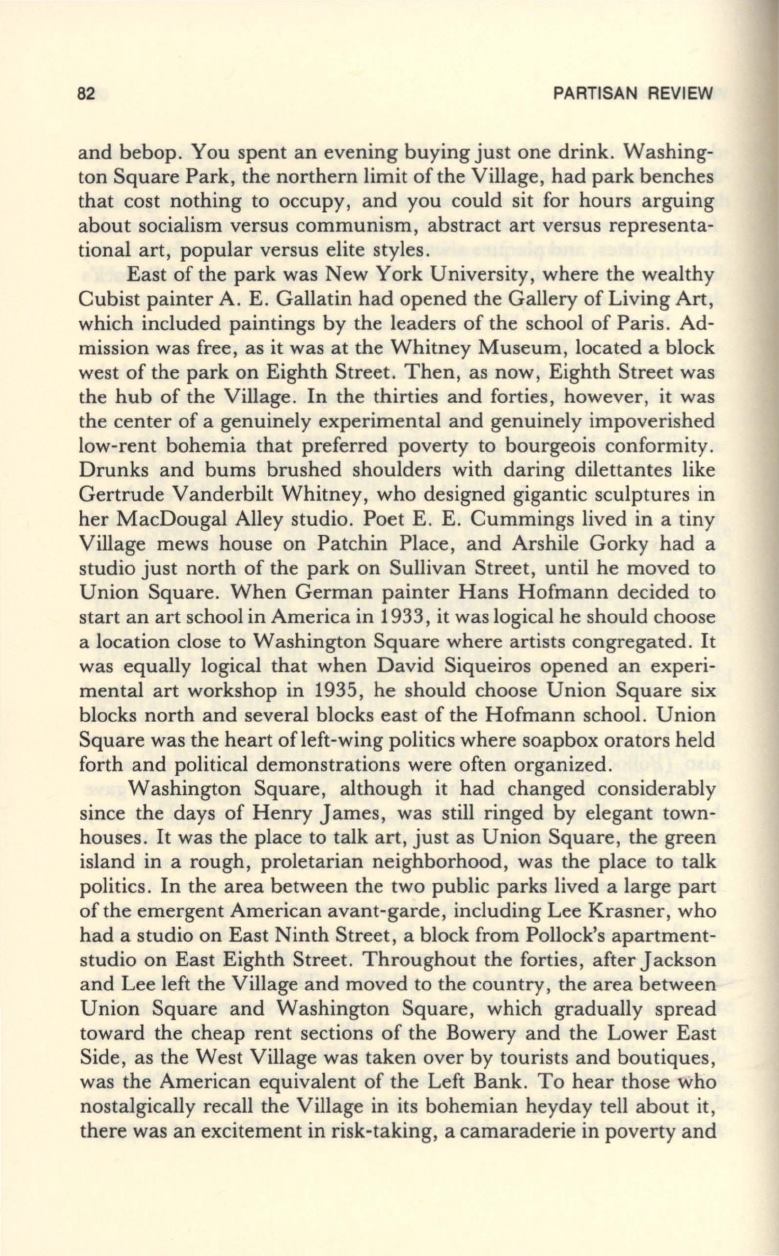
82
PARTISAN REVIEW
and bebop. You spent an evening buying just one drink. Washing–
ton Square Park, the northern limit of the Village, had park benches
that cost nothing to occupy, and you could sit for hours arguing
about socialism versus communism, abstract art versus representa–
tional art, popular versus elite styles.
East of the park was New York University, where the wealthy
Cubist painter A. E. Gallatin had opened the Gallery of Living Art,
which included paintings by the leaders of the school of Paris. Ad–
mission was free, as it was at the Whitney Museum, located a block
west of the park on Eighth Street. Then, as now, Eighth Street was
the hub of the Village. In the thirties and forties, however, it was
the center of a genuinely experimental and genuinely impoverished
low-rent bohemia that preferred poverty to bourgeois conformity.
Drunks and bums brushed shoulders with daring dilettantes like
Gertrude Vanderbilt Whitney, who designed gigantic sculptures in
her MacDougal Alley studio. Poet E. E. Cummings lived in a tiny
Village mews house on Patchin Place, and Arshile Gorky had a
studio just north of the park on Sullivan Street, until he moved to
Union Square. When German painter Hans Hofmann decided to
start an art school in America in 1933, it was logical he should choose
a location close to Washington Square where artists congregated.
It
was equally logical that when David Siqueiros opened an experi–
mental art workshop in 1935, he should choose Union Square six
blocks north and several blocks east of the Hofmann school. Union
Square was the heart of left-wing politics where soapbox orators held
forth and political demonstrations were often organized.
Washington Square, although it had changed considerably
since the days of Henry James, was still ringed by elegant town–
houses. It was the place to talk art, just as Union Square, the green
island in a rough, proletarian neighborhood, was the place to talk
politics. In the area between the two public parks lived a large part
of the emergent American avant-garde, including Lee Krasner, who
had a studio on East Ninth Street, a block from Pollock's apartment–
studio on East Eighth Street. Throughout the forties, after Jackson
and Lee left the Village and moved to the country, the area between
Union Square and Washington Square, which gradually spread
toward the cheap rent sections of the Bowery and the Lower East
Side, as the West Village was taken over by tourists and boutiques,
was the American equivalent of the Left Bank. To hear those who
nostalgically recall the Village in its bohemian heyday tell about it,
there was an excitement in risk-taking, a camaraderie in poverty and


